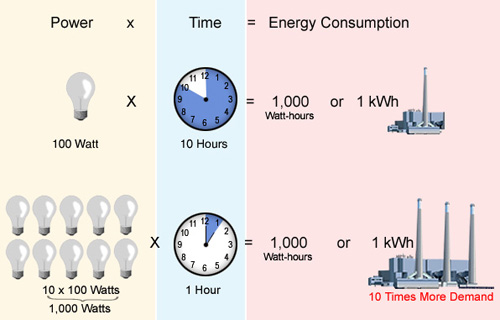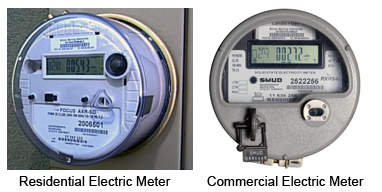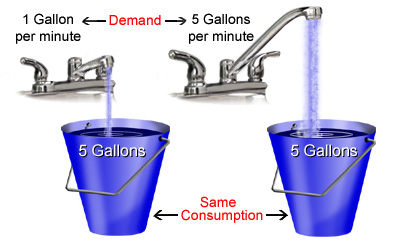Understanding Demand
Energy Consumption (kWh)
The basic measure of electric energy use is measured in kilowatt-hours or kWh. For example, a 100-watt light bulb consumes 100 watts per hour. If that bulb is left on for ten hours it will consume 1 kWh.
Demand (kW)
Demand is measured in kilowatts or kW. KW is the basic unit of electric demand and is equal to 1,000 watts. If ten 100 watt bulbs are left on for an hour that member is still consuming one kWh but it is also placing a 1 kW demand on the wholesale power provider by having all of the bulbs on at once.
Have you ever wondered what demand is? Click here to watch a video that explains electric demand.
What is demand?
"Demand" is the maximum electricity usage during the month over a specific period of time. Demand varies from hour to hour, day to day and season to season. This usage, which is expressed in kilowatts (kW, not kilowatt-hours), is called the "demand" on the system. Midwest Electric monitors demand over a 15-minute or 60-minute period (depending on the rate). The customer is charged for the highest 15-minute or 60-minute average recorded on the demand meter. After we read the meter each month, demand is reset to zero and the meter starts over, recording the highest 15-minute or 60-minute average for the next billing period.
What is demand charge?
Demand charge is based on each customer’s maximum 15-minute or 60-minute demand on the utility’s distribution system each month. Demand is measured in kilowatts (kW). Members are billed according to kW of demand for their rate.
Why are demand charges used?
Demand charges are the way your utility pays for generation and distribution capacity it needs to meet peak demand that occurs from time to time. The demand charges your utility pays to its wholesale power supplier is also calculated based on the highest demand during the month. We use the same method to bill demand to demand-rate members.
How can demand charges be reduced?
To reduce demand charge, simply examine your operation.
-
What energy-efficient improvements can be made?
-
Does all of the equipment need to be running at the same time?
-
If not, what can be turned off while other equipment is running?
Often there is equipment that is operated infrequently. If this is the case, can some other equipment be turned off while this equipment is running? The result may be a significant savings in your monthly demand charge.
Understanding Demand and Consumption
The difference between demand and consumption is vital to your choices in reducing your energy costs. A simple way to see the difference between demand and consumption is by considering two examples.
One 100-watt light bulb burning for 10 hours consumes 1,000 watt-hours or 1 kWh. The entire time it is on, it requires or "demands" 100 watts or 0.1 kW from the utility. That means the utility must have that 0.1 kW ready whenever the customer turns the lamp on.

Similarly, ten 100-watt light bulbs burning for 1 hour consume 1,000 watt-hours or 1 kWh. Note that in both examples, the consumption is 1 kWh, however, look how differently the second situation impacts the utility from a demand perspective. The serving utility must now be prepared to provide ten times as much capacity in response to the "demand" of the 10 light bulbs operating all at once.
If both of these customers are billed for their consumption only, both will get the same bill for 1 kWh of energy. And that is the way most residential customers are billed. But the requirement for the utility to meet this energy requirement is very different. In the second case, the utility has to have 10 times more generating capacity to provide the second customer's brief high demand for power compared to the first case.
Commercial and industrial customers are often billed for their hourly consumption patterns and their peak demand for energy. These customers often have special meters that measure both, unlike residential meters that just record total consumption in a time period, usually one month.

So, you might ask, "why doesn't the utility bill all customers for demand and consumption?" It seems that is only fair. Generally, it would be, but the fact is that most homes have a very similar demand profile and the meters capable of measuring both demand and consumption are much more expensive. At this time, the meters are far too expensive to justify having one on every home. As the cost of metering drops, and as automatic metering advances, we may see increased use of demand billing for homes.
Commercial customers need to be concerned with both demand and consumption billing.
Analogies for Understanding Demand and Consumption

Another way of understanding demand and consumption is with a "filling the bucket" analogy. Suppose you want to fill a 5 gallon bucket with water. You can use an inexpensive hose connection to your sink providing 1 gallon per minute to do it, and it will take 5 minutes. Or you can get to a more expensive large faucet that provides 5 gallons per minute, it will fill in just one minute. The flow rate is the equivalent to demand, and the 5 gallons of water are equivalent to consumption. In this example, filling both buckets has the same "consumption" but very different "demands."
The same is true of electricity. While you may be able to accomplish the same thing by operating a small wattage appliance for many hours as operating something of higher wattage for just a few, the higher wattage piece of equipment will create a higher demand on the utility. Using our analogy, you are asking for a larger pipe, and that costs more. If time is of the essence, it might be worth having the more expensive high flow rate or wattage. This is why utilities often charge some customers for both demand and consumption. A customer that sets a high demand requires more services from the utility, additional generating plant capacity, and more expense in lines, transformers, and substation equipment.

Some people like to use a car analogy to explain and understand how demand and consumption relate. The car's speedometer is like the demand meter and the odometer is like a consumption meter. Two cars could travel the same 100 mile road, one at 10 miles per hour for 10 hours and the other at 100 miles per hour for 1 hour. It takes a much more capable and expensive engine to power the car at 100 miles per hour than it does to power the one going only 10 miles per hour.

